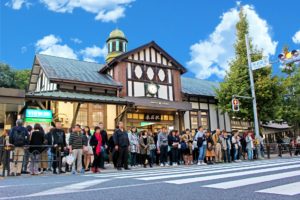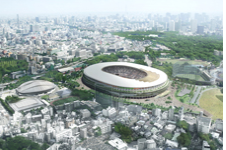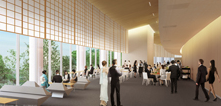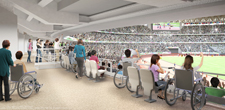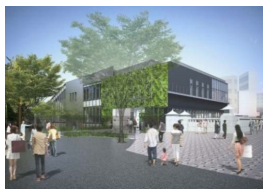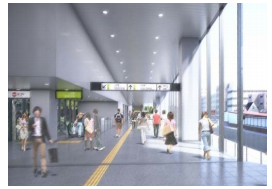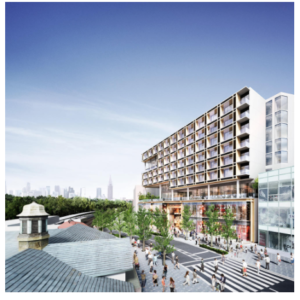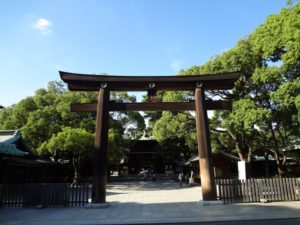(Current JR East ‘Harajuku’ station)
Tokyo will host the Rugby World Cup in 2019 and Olympics and Paralympics in 2020.
In view of the two big events and rapid growth of the inbound tourism, In Tokyo, there are a number of revamp projects in the pipe line now.
Today I pick up one of the projects by EAST Japan Railway Company (JR East)
involving Sendagaya station which is the closest station to the new National Stadium and Harajuku Ekimae project by NTT group.
Tokyo and neighbouring cities have been developed sufficiently and in a sense have been seeing the matured status
over the years,however, when the new development plans are revealed by the developers and the railway companies,
the real estate price in the redevelopment area picks up and price hike is likely to continue for over several years.
Therefore it is worthwhile to watch the new projects to plan your investments.
But why do the redevelopment projects give positive effect to the real estate price ?
There are three main reasons.
1. Commercial facilities are overhauled
In the approved redevelopment area, the land and buildings of the target area are expropriated under the law.
The developers usually can secure a enough space to accommodate large-scale commercial facilities.
The existing commercial facilities are either torn down or completely overhauled from the viewpoint of sound advanced utilization of land in urban areas.
When the commercial facilities are refreshed, the convenience of the area will be enhanced and the future value of the area can be expected to rise.
2. People come and live
In areas where commercial facilities have been enhanced and convenience improved, the number of people who would like to live there will naturally increase.
The more people who want to live, the more demand in many economic respects will be created.
More people attract more business and better environment.
3. Branding value improves
In the area where the commercial facilities are renewed, people come for living and shopping.
The massive expansion and redevelopment could change the look, feel and operations of the area.
An article by Nikkei on September 20, 2017 reports:
“According to the latest report by Tokyo metropolitan government, commercial land in the five central wards of Tokyo, Chiyoda, Chuo, Minato, Shinjuku and Shibuya on average grew by 6%
vs. previous year.
The areas in which the large redevelopment projects in progresses are prominent where the rate of growth is high.
For example, Yaesu 2 chome district in Chuo-ward (which is close to JR Tokyo station) rose by 13.9% vs. previous year
In the neighborhood of Yaesu 2 chome, a compound commercial facility called “Kyobashi Edogrand” opened in autumn 2016. “
Let’s take a closer look at the redevelopment projects which are closely linked to 2020 Tokyo Olympics.
The new National Stadium in Tokyo redevelopment is a three-year plan and the current stadium is being completely torn down
and the new stadium will be rebuilt by Olympic and Paralympics 2020.
The overall project deal is said to be 149 billion yen (about U$1.4 billion). It is a huge project.
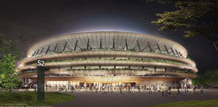
(Artist impression of the new national stadium in Sendagaya)
In the meantime, JR East has announced 25 billion yen (U$240 million) project to redevelop three stations in central
Tokyo in preparation for the 2020 Olympics and a separate project to build the commercial building in Harajuku area
has been unveiled by Japan’s largest telecom group NTT.
Tokyo has been constantly evolving even before the Olympic news but Olympics certainly accelerated
the pace of a number of redevelopment projects all over central Tokyo.
Tokyo and neighbouring cities have been developed and in a sense see the matured status over the years,however,
when the new development plans are revealed by the developers and the railway companies,
the real estate price in the area usually picks up.
Therefore it is worthwhile to watch the new redevelopment projects to bet your investment.
These three stations are Sendagaya, Shinanomachi and Harajuku.
They are all expected to accommodate large numbers of passengers including foreign tourists to and from the Olympic events.
JR East is planning to revamp these stations with larger concourses, additional ticket gates, and barrier-free access.
These three stations are close to Shibuya (only 5 mins away by train).
Shibuya is always vibrant and synonymous with more than just shopping and entertainment:
it’s a great place to base people for work as well.
Any way, the project JR East unveiled is as follows:
Revamping plan of three stations: Sendagaya, Shinanomachi and Harajuku
the total construction cost of 3 stations is expected to be about 25 billion yen (U$240 million)
At Sendagaya station, JR East is planning to relocate the ticket gate to the Shinjuku side so that the flow of the traffic
becomes smooth.
In addition to extending ticket gates and concourses to alleviate congestion, automatic concourse doors will be installed.
At Shinano-cho station, installing new automatic concourse doors is planned to improve safety and
the number of elevators and the toilets will be increased.
At Harajuku station, JR East will build a two-story station concourse.
– Sendagaya Station
① Current temporary concourse will dedicated for Shinjuku direction.
② Extend the ticket gates and concourse to reduce congestion.
③ Relocate the ticket gate to Shinjuku side so that the flow line of customers will be smooth.
④ install a new home door to improve safety.
⑤ expand barrier-free facilities such as additional elevators and toilet facilities.
– Shinanomachi Station
① Build new concourse automatic doors to improve safety.
② Add the new elevators and extend the toilet facilities.
– Harajuku Station
① The temporary concourse which is used only during the New Year holidays will be a permanent one.
② Build the new 2 railway station buildings on railway track and concourse which will expand and revamp concourse, ticket gates, toilets
to reduce the congestion.
③ Build a new gateway on the Meiji Shrine side.
④ The externally dedicated concourse will be newly built connecting to the Takeshita street exit.
(Artist impression of new Harajuku station by JR East)
(Artist impression of new concourse of Harajuku station by JR East)
Another project was announced by one of a group company of Telecom Giant NTT, ‘NTT Urban Development Co., Ltd.’
NTT Urban Development recently announced that the project in front of Harajuku Station. (Harajuku Ekimae project)
Harajuku Ekimae PJ is a project to rebuild multiple sites including Harajuku Apartments completed in 1959.
This plan is located between the historic Omotesando as the approach to Meiji Shrine and
Takeshita street which is the very origin of the Japan’s pop culture.
A complex building of commercial and rental housings will be developed in front of JR Harajuku station
with a building of 10 floors / underground 3 stories.
It will be completed by the spring of 2020 Olympic year.
Total project cost is about 55 billion yen (U$520 million)
The project will capture commercial demand in a newly built compound building accommodating foreigners visiting Japan and the Olympics.
Their strategy is to attract fashion and sports related tenants and people
by taking advantage of the characteristics of the place.
80 condominiums will be built on the higher floors with relatively small residence area, which caters to the fashion industry.
There are a number of other mega projects in progress in central Tokyo and I will post the article about them in due course.
(Artist image of Harajuku Station ekimae building by NTT Urban Development)
New National Stadium (in Japanese)
JR East announcement (in Japanese)
NTT building project in Harajuku station (in Japanese)
Toshihiko Yamamoto
Real estate investing consultant and author.
Toshihiko is currently writing a book about the real estate investing in Japan
for foreign investors.
Founder of Yamamoto Property Advisory in Tokyo.
International property Investment consultant and licensed
real estate broker (Japan).
He serves the foreign companies and individuals to buy and sell
the real estates in Japan as well as own homes.
He holds a Bachelor’s degree in Economics from
Osaka Prefecture University in Japan
and a MBA from Bond University in Australia
(Meiji Shrine which is 5 mins walk from Harajuku station)

